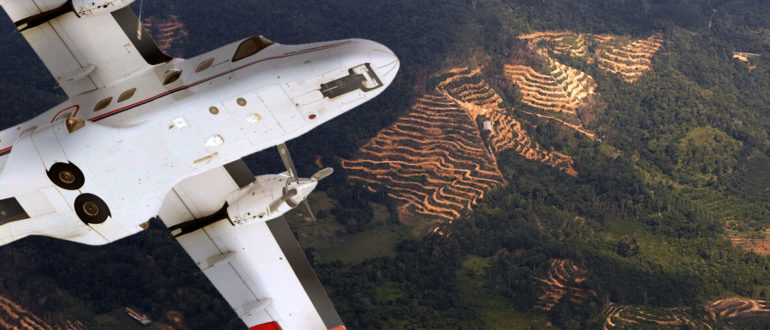In light of the United Nations (UN) declaration that 2021-2030 is the U.N. Decade on Ecosystem Restoration,
a group of scientists is voicing concerns about restoration in heavily fragmented landscapes under a hotter and drier future scenario.
Poor recovery of small fragments will end up costing management and wider society later down the line. Millions are invested in setting aside patches, but management is weak and costly.
Rainforests turn into oil palm plantations
The past 40 years in Southeast Asia have seen about 50% of lowland rainforests converted to oil palm and other plantations, and much of the remaining forest heavily logged.
Little is known about how fragmentation influences recovery and whether climate change will hamper restoration.
“Here, we use repeat airborne LiDAR surveys spanning the hot and dry 2015-16 El Niño Southern Oscillation (ENSO) event to measure canopy height growth across 3,300 ha of regenerating tropical forests spanning a logging intensity gradient in Malaysian Borneo,” says postdoctoral researcher Matheus Nunesfrom the University of Helsinki, lead author of the paper recently published in Nature Communications.
Repeat high-density airborne LiDAR across the human-modified forests of Borneo provided a unique perspective on the regrowth of forests during the 2015-2016 ENSO and the environmental controls on the canopy. Regeneration of logged forests was still positive during the hot and dry ENSO in Borneo, when the highest temperatures and the highest VPD exceeded 2.1 °C and 140% the local long-term average during non-El Niño years. The results demonstrate that regenerating logged forests in this landscape—which contain a high abundance of pioneer tree species with acquisitive traits—continued to grow, despite the high temperatures and water demand in these logged forests.
However, the predictions revealed in the paper show that environmental controls were key to modulating regrowth at the landscape level.
Fragmentation effects increased exponentially with proximity to oil palm plantations, which is consistent with the long-term fragmentation effects that lead to tree mortality and lower productivity.
“Additionally, we demonstrate that the position of fragmented forests across the landscape was also a predictor of forest growth, with valleys and riparian forests showing higher canopy growth compared to those on hilltops during the El Niño,” says Nunes.
Suggestions to the Roundtable for Sustainable Oil Palm
Oil palm companies that have joined the Roundtable for Sustainable Oil Palm are committed to the protection of high conservation value forests along rivers and on steep slopes within their estates.
“Our results suggest buffers have to be wide (at least 40 m on each side of the river) to ensure the interior of the strip retains a stable canopy height during droughts,” says Nunes.
This is twice the width of what is currently required by law in Sabah, Malaysia. If designed and protected appropriately, riparian reserves in oil palm estates support regrowth with potential positive consequences for the global carbon cycleand for ecosystem function.
The results also demonstrate that small, fragmented patches of regenerating logged forests left on hilltops will be slow to recover due to lower water availability, particularly as El Niño events are becoming more frequent as a result of climate change. Fragmentation in these regenerating logged forests leads to consistent canopy loss within 110 m from oil palm plantations. These results suggest that small patches of logged forests on hilltops will not recover, reflecting the intertwined effects of fragmentation and climate.
Logged rainforests can be an ‘ark’ for mammals, extensive study shows
More information:
Matheus Henrique Nunes et al. Recovery of logged forest fragments in a human-modified tropical landscape during the 2015-16 El Niño, Nature Communications (2021). DOI: 10.1038/s41467-020-20811-y
Provided by
University of Helsinki
Citation:
Ecosystem restoration is a pressing issue in fragmented rainforest (2021, March 9)
retrieved 9 March 2021
from https://phys.org/news/2021-03-ecosystem-issue-fragmented-rainforest.html
This document is subject to copyright. Apart from any fair dealing for the purpose of private study or research, no
part may be reproduced without the written permission. The content is provided for information purposes only.



